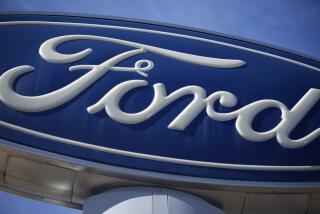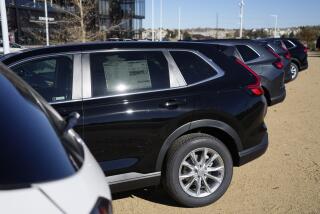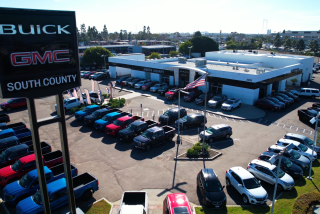GM to Shift Gears, Focus on Passenger Cars
BAKERSFIELD — Spurred by their success with light trucks, General Motors Corp.’s top executives said Tuesday that they will turn their focus to passenger cars, for which the world’s largest auto maker has lost almost 10 points of market share in the last decade.
Having finally overtaken longtime truck leader Ford Motor Co. in the U.S. last year, GM wants to regain lost ground in the less-profitable but strategically critical car market.
“Where we need to do better is passenger cars. We don’t want to accept a situation where our gains in truck penetration are offset by losses from our cars,” Vice Chairman Bob Lutz said in an interview.
“I just can’t see the world’s largest auto maker abdicating a market of 8 million passenger cars,” Lutz told The Times at the Button Willow Raceway in Bakersfield, where GM was demonstrating several of its newest and future models.
GM will build up its passenger-car offerings with redesigns, new engines, new transmissions and, above all, new models.
Underscoring the new direction toward cars, GM took the unprecedented step Tuesday evening of showing journalists 13 future vehicles--12 of which were passenger cars. GM showed the vehicles on condition that details not be published.
GM has 33% of the U.S. market for light trucks--pickup trucks, sport utility vehicles and light trucks--making it the market leader, thanks to a series of large and mid-size pickup trucks and SUVs introduced in the last three years by the Chevrolet, GMC, Buick and Cadillac divisions.
But GM’s share of the U.S. passenger car market plunged from 35.9% in 1991 to 26.9% in 2001, as competitors from Japan and Germany ate into the Big Three’s home market.
Japanese and Korean auto makers dominate the entry-level car market of compacts and subcompacts, and Volkswagen has made huge gains in the middle of the passenger-car market, with Audi, BMW and Mercedes-Benz greatly increasing their sales at the high end.
GM will continue its efforts in the entire market as it shifts its attention to cars, Chief Executive Rick Wagoner said.
“The philosophy is, let’s drive to have the same success in passenger cars we’ve had in trucks,” Wagoner said in an interview.
“It doesn’t mean that we have any less emphasis on trucks, because that’s still important--it’s still the biggest part of the market in the U.S. and it’s still the biggest profit driver,” he said.
The GM executives’ comments come a week after Chrysler Group Chief Executive Dieter Zetsche said Chrysler, which from the mid-’80s was the most aggressive of the Big Three in shifting its product mix from cars to trucks, would concentrate on becoming more competitive in passenger cars.
Ford is the best-selling passenger-car brand in the country, ahead of No. 2 Chevrolet, and the world’s second-largest auto maker says it is intent on strengthening its car lineup.
“While trucks and SUVs are obviously an important part of our business and will remain key, we are equally passionate about leadership in the car market,” Chris Theodore, Ford vice president for North American product development, said Tuesday.
GM’s assault on the passenger-car market will be across all brands, said Gary Cowger, president of GM North America.
“To be a full-line manufacturer you have to be good at both cars and trucks,” he told The Times.
Future GM vehicles include a roadster and a “crossover” SUV/car for Cadillac, a redesigned Pontiac Grand Am, Grand Prix and Bonneville as well as an all-new sporty Pontiac coupe, a new Buick Regal, a seven-seater crossover for Buick and another probably for Chevrolet, a redesigned Saturn L-series and an all-new Saturn compact coupe and sedan, and new small-car replacements for the Chevrolet Cavalier and Pontiac Sunfire.
More to Read
Inside the business of entertainment
The Wide Shot brings you news, analysis and insights on everything from streaming wars to production — and what it all means for the future.
You may occasionally receive promotional content from the Los Angeles Times.










